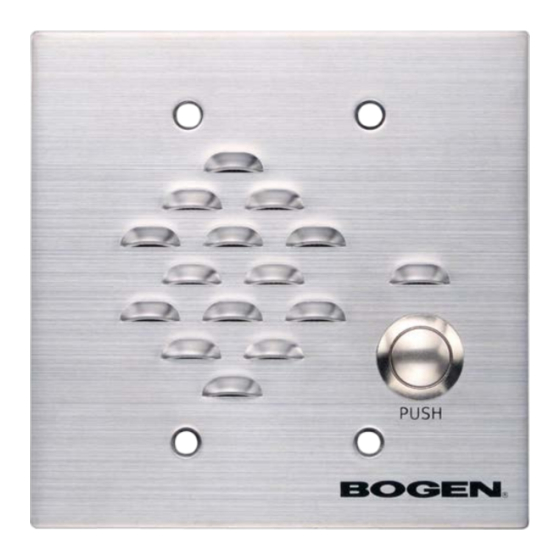Summary of Contents for Bogen NQ-EDP01
- Page 1 Entry Door Phone Configuration Guide NQ-EDP01 © 2021 Bogen Communications, Inc. All rights reserved. 740-00142A 211011...
-
Page 2: Table Of Contents
Contents Configuring Nyquist Entry Door Phone ........1 Using the Dashboard . -
Page 3: Configuring Nyquist Entry Door Phone
Configuring Nyquist Entry Door Phone The Nyquist Entry Door Phone (NQ-EDP01) is a hands-free, two-way, wall-mounted, VoIP speaker phone designed to work with the Nyquist Series IP network-based intercom and paging solution. It is 802.3af-compliant and designed to facilitate rapid and efficient deployment using existing network Power over Ethernet (PoE) ports. -
Page 4: Using The Dashboard
Link icon. At the Nyquist Appliance Login page, enter username and password, and then select Login. The default username is admin; the default password is bogen. The dashboard for the selected appliance appears. Using the Dashboard Figure 2. -
Page 5: Updating Firmware
Table 1. Appliance Dashboard Fields Firmware Version Provides the firmware version installed on the station. Standalone Operation Enables or disables Standalone mode. The following buttons are available at the top of all pages in the application. Table 2. Appliance Dashboard Buttons Dashboard Displays the dashboard. - Page 6 Check for Updates button checks the Bogen website for the latest firmware version available. If a version newer than the one currently installed is found, it is downloaded to the appliance. If you already have a firmware file you would like to install to the appliance, select Upload Firmware to upload the firmware file from your computer to the appliance.
-
Page 7: Network Settings Tab Parameters
Check for Updates Available only when the appliance is configured for Standalone mode. Checks the Bogen website for the latest firmware version available and, if it finds a version newer than what is currently installed, downloads it to the appliance. - Page 8 Select your desired network settings. Select Save. Figure 4, Network Settings Network settings are described in the following table: Table 4, Network Settings IP Address Identifies the IP address assigned to the appliance. Netmask Identifies the subnetwork subdivision of an IP net- work.
- Page 9 Table 4, Network Settings (Continued) NTP Server Identifies the IP address or the domain name of the Network Time Protocol (NTP) Server. Note: This field is only editable when Standalone Operation is enabled. TFTP Server Identifies the host name or IP address of the Trivial File Transfer Protocol (TFTP) server.
-
Page 10: Configuration Settings Tab Parameters
Table 4, Network Settings (Continued) DHCP Enabled Indicates if the device is enabled to use DHCP to retrieve its IP configuration. Reboot Appliance Indicates that this appliance should reboot when the Save button is clicked. Configuration Settings Tab Parameters The easiest way to configure Nyquist appliances is to obtain configuration settings from the Nyquist server by selecting Get Configuration From Server. - Page 11 The following table describes the Configuration Settings tab settings: Table 5. Configuration Settings (Standalone disabled) Get Configuration from Retrieves configuration settings (i.e., web username, server, and local port) from the TFTP server specified in Server the Network Settings (see "Network Settings Tab Parameters”...
- Page 12 Standalone Operation Configuration Settings Figure 6. Appliance Configuration Settings (Standalone enabled) The following table describes the Configuration Settings tab settings when Standalone Operation is enabled for this device: Table 6. Configuration Settings (Standalone enabled) Device Type Displays the type of this device. Device Name Provides a name for this device.
-
Page 13: Accessing Log Files
Table 6. Configuration Settings (Standalone enabled) SIP Extension Specifies the SIP extension for this device. The extension, along with the IP address, is used to specify the URI used to place a SIP call to this extension: sip:<extension>@<local_ip_address> SIP Network Port Specifies the IP port on which to communicate with the SIP Registration Server (typically 5060). - Page 14 Figure 7, Logs Available logs are described in the following table. If a log file is empty, however, it will not appear in the drop-down list of available logs. Table 7, Logs Description ampws.log Contains information about protection status and logs protection events with temperature information at the time of event.
-
Page 15: Setting Dsp Parameters
Table 7, Logs (Continued) Description kern.log Contains information logged by the kernel and recent login information for all users. lastlog Contains information on the last login of each user. messages Contains messages generated by Nyquist. php5-fpm.log Contains errors generated by the PHP script. syslog Contains list of errors that occur when the server is run- ning and server start and stop records... - Page 16 Figure 8. DSP Page From this page, you can configure the device’s Digital Signal Processing (DSP) features, a form of processing that uses digital data to simulate characteristics found in analog cir- cuits. With DSP, you can alter analog signals, such as audio or video signals, that have been converted to a digital format.
- Page 17 Intercom Tuning The Entry Door Phone provides half-duplex communications, which means that only one party can transmit at a time. Which party can transmit (i.e., this Entry Door Phone or the Admin Phone) is controlled automatically by the Intercom Tuning settings. Whenever a signal from the Admin Phone exceeds a certain level—known as the switching sensitivity level—the Entry Door Phone switches to receive mode, allowing the party using the Admin Phone to speak.
- Page 18 Table 9. Intercom Tuning Settings Switching Sensitivity Specifies the input level above which the Admin Phone transmits, below which the Entry Door Phone transmits. The range is -90 to -20 dB.





Need help?
Do you have a question about the NQ-EDP01 and is the answer not in the manual?
Questions and answers